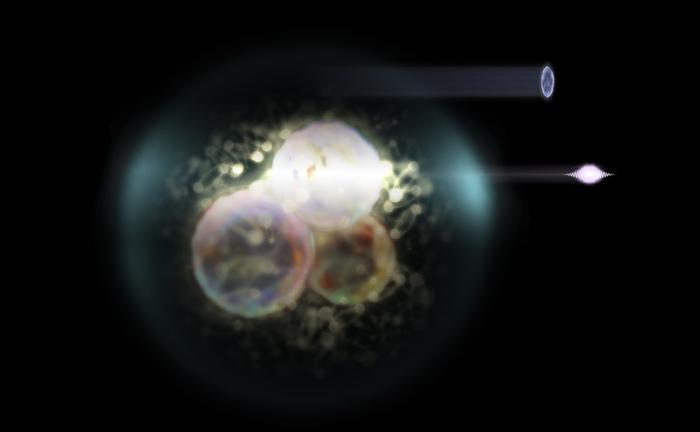
In a groundbreaking study, physicists have harnessed quantum information tools to gain unprecedented insights into the enigmatic internal structure of protons. This fascinating endeavor, which has made waves in the scientific community, showcases the dynamic and complex interplay of quarks, gluons, and virtual particles that formulate the essence of protons. Through the innovative use of quantum entanglement, researchers have unveiled how this fundamental particle interacts during deeply inelastic collisions, enhancing our comprehension of matter at its most fundamental level.
The research reveals that inside a proton, a whirlwind of quantum entanglement occurs among its constituent particles, primarily quarks and gluons. Unlike traditional approaches that often simplify the internal dynamics of the proton, this study introduces a sophisticated formalism that effectively encapsulates the complexity of quantum entanglement and its contributions to the internal structure of protons. Historically, the intricate interactions within protons, often described as a ‘boiling sea’ of virtual particles, posed significant challenges in theoretical physics. The findings suggest that these interactions can not only be modeled but also predicted with remarkable fidelity.
To probe this complexity, physicists conducted experiments where high-energy photons are exchanged during electron-proton collisions. It is through these exchanges that a relativistic electron emits a high-energy photon as it strikes the proton, allowing the photon to penetrate the proton’s interior. This interaction allows scientists to ascertain the properties of the proton’s internal structure by examining the secondary particles produced from these high-energy collisions. Remarkably, the photon, in its electromagnetic wave form, engages with the fundamental constituents of the proton, leading to a cascade of observable outcomes.
This research originates from a collaborative effort among scientists from various prestigious institutions, pooling their expertise to unravel one of nature’s mysteries. In particular, researchers from Brookhaven National Laboratory, Stony Brook University, and other international collaborators have come together to share knowledge and theoretical models. The collective efforts exemplify the potential of interdisciplinary science in tackling fundamental issues in physics, urging a paradigm shift in the way we perceive subatomic particles.
Moreover, one of the key contributions of this study is the formulation of entanglement entropy, which serves as an essential tool in quantifying the complexity of entangled states within the proton. It provides a measurable way to understand the entanglement amongst the constituent partons of the proton. When a photon interacts with a proton, it ‘observes’ only part of the entangled quarks and gluons, leading to a calculation of non-zero entanglement entropy. This entropy signifies the hidden complexity within the proton, representing the vast quantum information that is not directly accessible during measurement.
As this research progresses, the entanglement entropy framework opens new avenues for understanding how quarks and gluons interact and bind within protons. This aspect is crucial, as understanding the underlying principles of entanglement may lead to breakthroughs in theories related to strong nuclear interactions. Scientists anticipate that by elucidating these relationships, they can answer overarching questions about the formation and stability of atomic nuclei, advancing our theoretical foundation in nuclear physics.
The implications of this study extend beyond theoretical exploration and touch upon experimental predictions as well. By employing the groundbreaking entanglement framework, researchers demonstrated the capacity to predict the entropy of hadrons generated during electron-proton collisions accurately. This predictive capability has been validated against data from previous particle accelerator experiments and highlights a significant milestone in the field of theoretical physics.
The research team expects that utilizing this sophisticated entanglement-based framework will improve future experimental designs, particularly as new particle accelerators, such as the Electron-Ion Collider, come online. These facilities will provide researchers with enhanced opportunities to probe the interiors of not just protons but ions, allowing for deeper explorations into the regions where quantum entanglement and strong interactions coalesce.
Such advancements promise not merely to augment standard models of particle physics but also to challenge and refine our understanding of the fundamental forces that govern matter. The application of quantum information theory in the study of protons unveils a realm of potential discoveries that could transcend mere mappings of particle interactions and delve into the very fabric of reality.
As the scientific community embraces the revelations stirred by this research, the findings emphasize the importance of collaboration across multidisciplinary fields in making substantial strides in our understanding of nature. The integration of quantum mechanics with particle physics sheds light on the underlying principles that govern subatomic interactions, reinforcing the notion that entanglement lies at the core of quantum phenomena.
In conclusion, this study heralds a new era in the investigation of protons, showcasing the interplay between quantum entanglement and particle interactions. This multidimensional approach offers profound insights that could reshape our foundational theories and unveil new answers to longstanding questions in modern physics, thus reigniting the quest to comprehend the complexities of matter at the most fundamental level.
Subject of Research: Understanding the quantum entanglement within protons
Article Title: QCD evolution of entanglement entropy
News Publication Date: 5 February 2025
Web References: Institute of Nuclear Physics, Polish Academy of Sciences
References: DOI: 10.1088/1361-6633/ad910b
Image Credits: Credit: Source: IFJ PAN, jch
Keywords
Quantum Mechanics, Particle Physics, Theoretical Physics, Nuclear Physics, Quantum Information, Entanglement, Strong Interactions, Hadrons, Protons, Quarks, Gluons, High-Energy Physics
Tags: complexity of subatomic particlesdeeply inelastic collisions studygroundbreaking physics researchhigh-energy photon exchangesinsights into proton internal structuremodeling proton dynamicsquantum entanglement in protonsquantum information techniques in physicsquarks and gluons interactionstheoretical physics advancementsunderstanding matter at fundamental levelsvirtual particles in quantum mechanics





